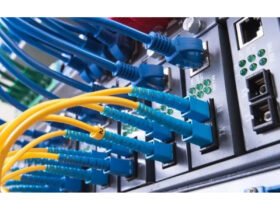Small to medium-sized businesses (SMBs) often face unique challenges when it comes to cybersecurity. Many lack the resources to hire in-house IT teams, leaving them vulnerable to data breaches, ransomware attacks, and compliance issues. This case study explores how one growing retail business implemented managed IT services to overhaul its security infrastructure, mitigate risks, and protect sensitive customer data.
The Business at a Glance
- Industry: Retail (E-commerce and Brick-and-Mortar)
- Size: 45 employees
- Challenge: Frequent cyber threats and lack of a robust IT security strategy
- Solution: Adoption of managed IT services with a focus on security
Identifying the Problem: A Patchwork Approach to Cybersecurity
The company, a regional retail chain with an expanding e-commerce presence, encountered repeated security issues due to its fragmented IT setup. The symptoms of their challenges included:
- Data Breaches: A phishing email had compromised employee credentials, exposing sensitive customer payment information.
- Outdated Software: Systems were not consistently updated, leaving vulnerabilities for hackers to exploit.
- No Incident Response Plan: The absence of a formal incident response strategy led to extended downtime after attacks.
- Compliance Issues: Their payment processing system did not fully comply with PCI DSS standards, putting the company at risk of legal and financial penalties.
Without a dedicated IT department, the company relied on ad-hoc fixes from a part-time consultant, which proved ineffective as the business grew.
Partnering with a Managed IT Services Provider
Realizing the need for a strategic approach to IT security, the company partnered with a managed IT services provider (MSP) specializing in cybersecurity for SMBs. The partnership aimed to create a proactive, scalable security infrastructure while ensuring compliance with industry standards.
Key Objectives
- Strengthen the company’s cybersecurity defenses
- Minimize downtime caused by IT disruptions
- Ensure compliance with regulatory frameworks
- Provide ongoing monitoring and threat detection
Implementing the Solution: A Holistic Approach to Managed Security
The MSP conducted a thorough assessment of the company’s IT environment, identifying vulnerabilities and prioritizing areas for immediate action. The implementation process included the following steps:
1. Endpoint Protection and Monitoring
The MSP deployed advanced endpoint security software on all devices, including employee laptops, point-of-sale systems, and company servers. This software provided real-time monitoring and automatic threat detection.
- Result: Blocked over 150 potential threats within the first three months, including malware and phishing attempts.
2. Firewall and Network Security Upgrades
To address gaps in network security, the MSP installed a next-generation firewall with intrusion detection and prevention capabilities. Regular penetration tests were scheduled to identify weaknesses.
- Result: Unauthorized access attempts decreased by 70%, ensuring customer data remained secure.
3. Software Patch Management
The MSP automated the process of updating software and operating systems to eliminate vulnerabilities caused by outdated programs.
- Result: Reduced the risk of exploitation through known vulnerabilities by over 90%.
4. Employee Training
Recognizing that human error was a significant factor in previous breaches, the MSP introduced a cybersecurity awareness program. Employees received training on recognizing phishing emails, creating strong passwords, and adhering to IT policies.
- Result: Employee-reported phishing attempts increased, demonstrating heightened awareness and vigilance.

5. Backup and Disaster Recovery
The MSP implemented a robust backup solution with automatic daily backups stored securely in the cloud. A disaster recovery plan was developed, ensuring quick restoration of operations in the event of a breach or system failure.
- Result: Downtime due to IT incidents was reduced from an average of 12 hours to less than 2 hours.
Overcoming Challenges During Implementation
While the results were promising, the implementation process was not without its challenges:
- Resistance to Change: Some employees were initially resistant to new security protocols, such as mandatory multi-factor authentication (MFA).
- Time Constraints: Integrating new systems during peak shopping seasons required careful scheduling to avoid disruptions.
- Legacy System Compatibility: Updating older systems to work seamlessly with modern security solutions required significant customization.
By maintaining open communication and providing on-site support, the MSP addressed these challenges effectively.
Results: A Secure and Resilient IT Environment
Within six months of implementing managed IT services, the retail business experienced measurable improvements across multiple areas:
- Zero Data Breaches: No customer data was compromised after the new systems were installed.
- Compliance Achieved: The company met all PCI DSS requirements, avoiding potential fines and ensuring customer trust.
- Cost Savings: By preventing downtime and reducing reliance on ad-hoc IT consultants, the business saved approximately $25,000 annually.
- Increased Customer Confidence: Enhanced security measures were communicated to customers, boosting trust and retention rates.
Lessons Learned and Recommendations
The success of this case highlights several key takeaways for businesses considering managed IT services for security:
- Proactive Measures Save Costs: Preventing breaches is far more cost-effective than dealing with the aftermath.
- Employee Training Is Essential: Even the most advanced technology can’t compensate for a lack of cybersecurity awareness among staff.
- Choose an MSP With Relevant Expertise: Working with a provider experienced in your industry ensures that security solutions align with specific needs and challenges.
- Regular Assessments Are Necessary: Cybersecurity threats evolve, making ongoing evaluations and updates critical to long-term protection.
Conclusion
For this retail business, managed IT services proved to be a transformative solution, enabling them to shift from a reactive to a proactive approach to cybersecurity. By partnering with a reliable MSP, they not only safeguarded their operations but also enhanced customer trust and compliance. Small businesses looking to strengthen their security infrastructure can take inspiration from this case, recognizing the immense value that managed IT services bring in an era of ever-increasing cyber threats.







